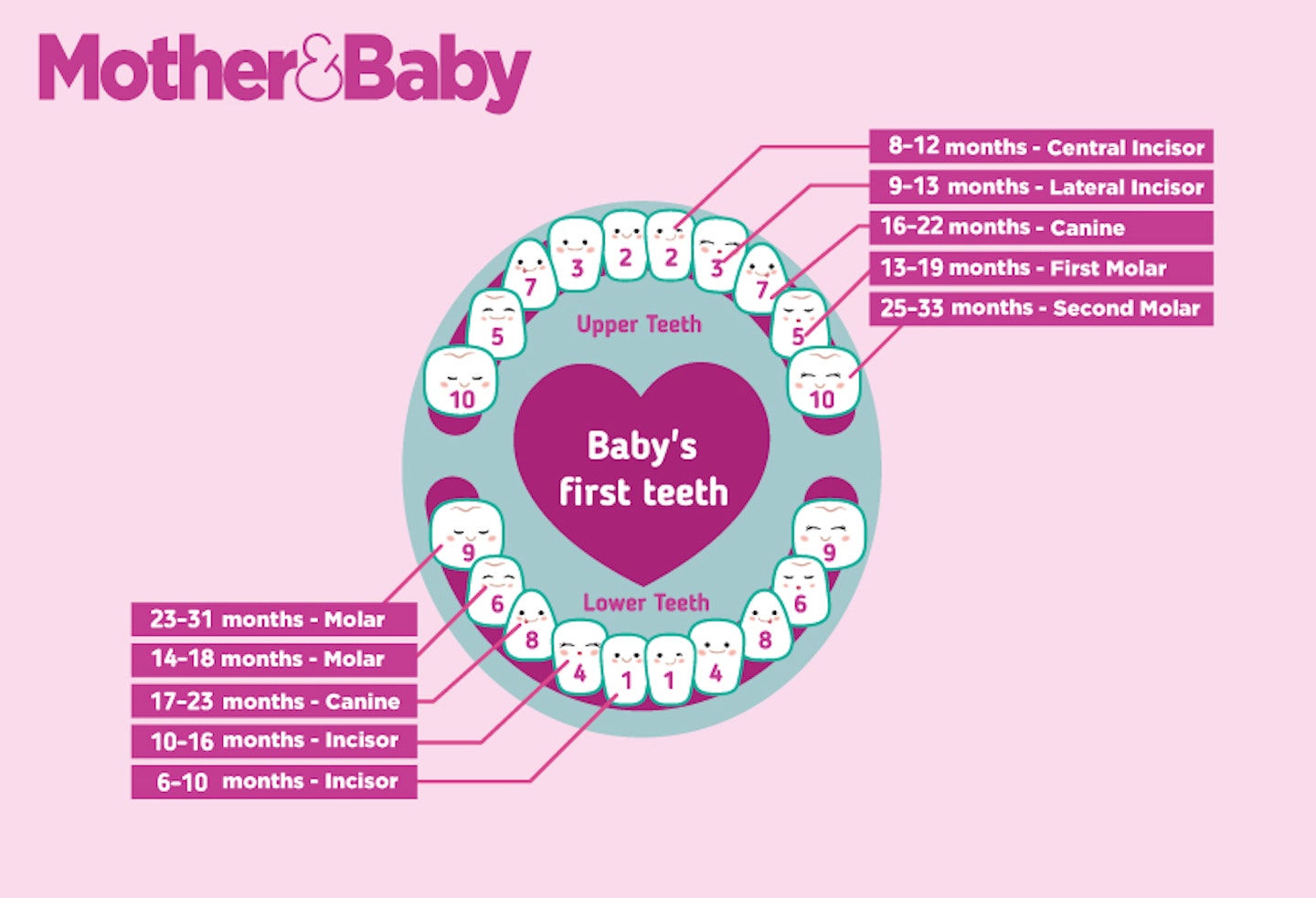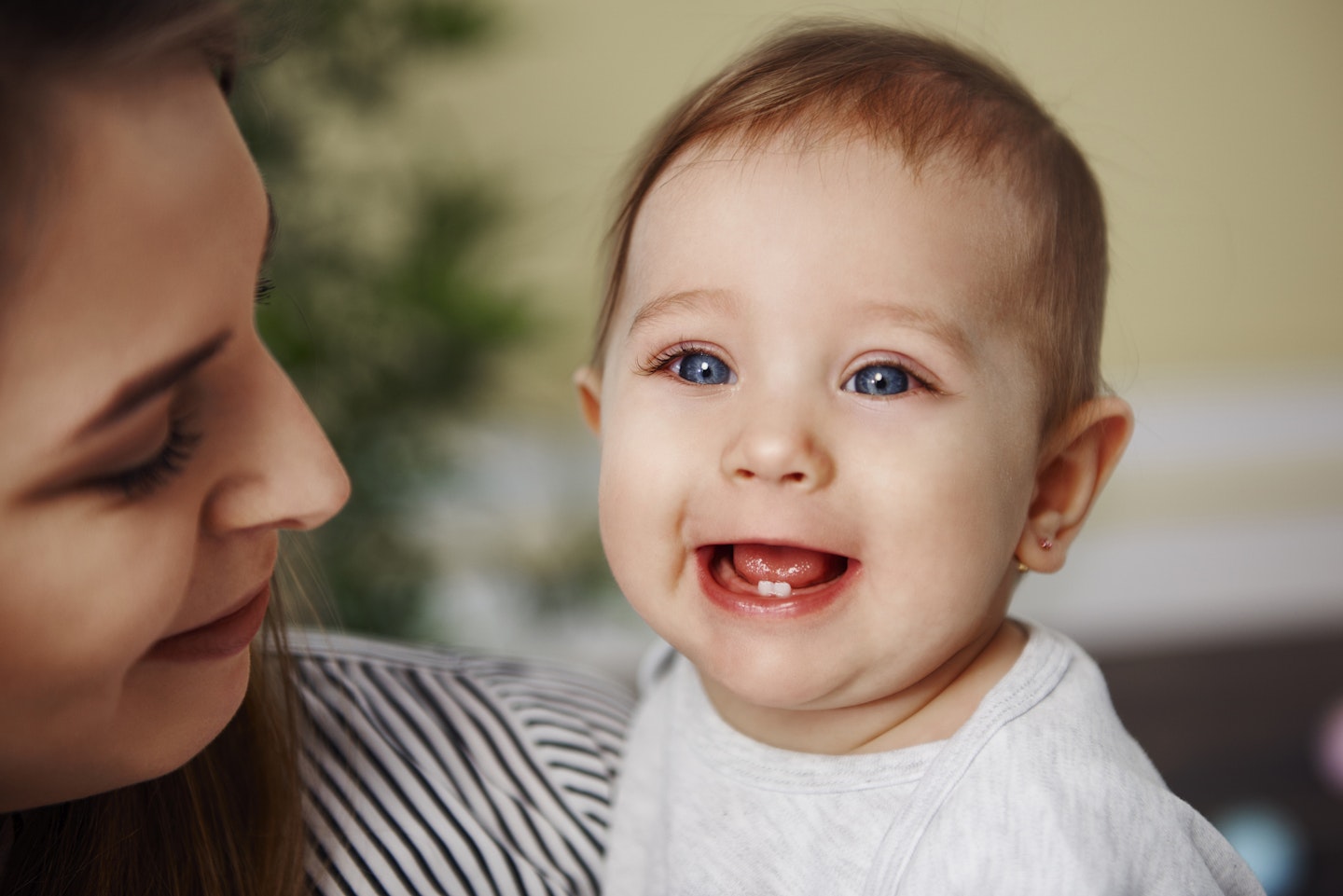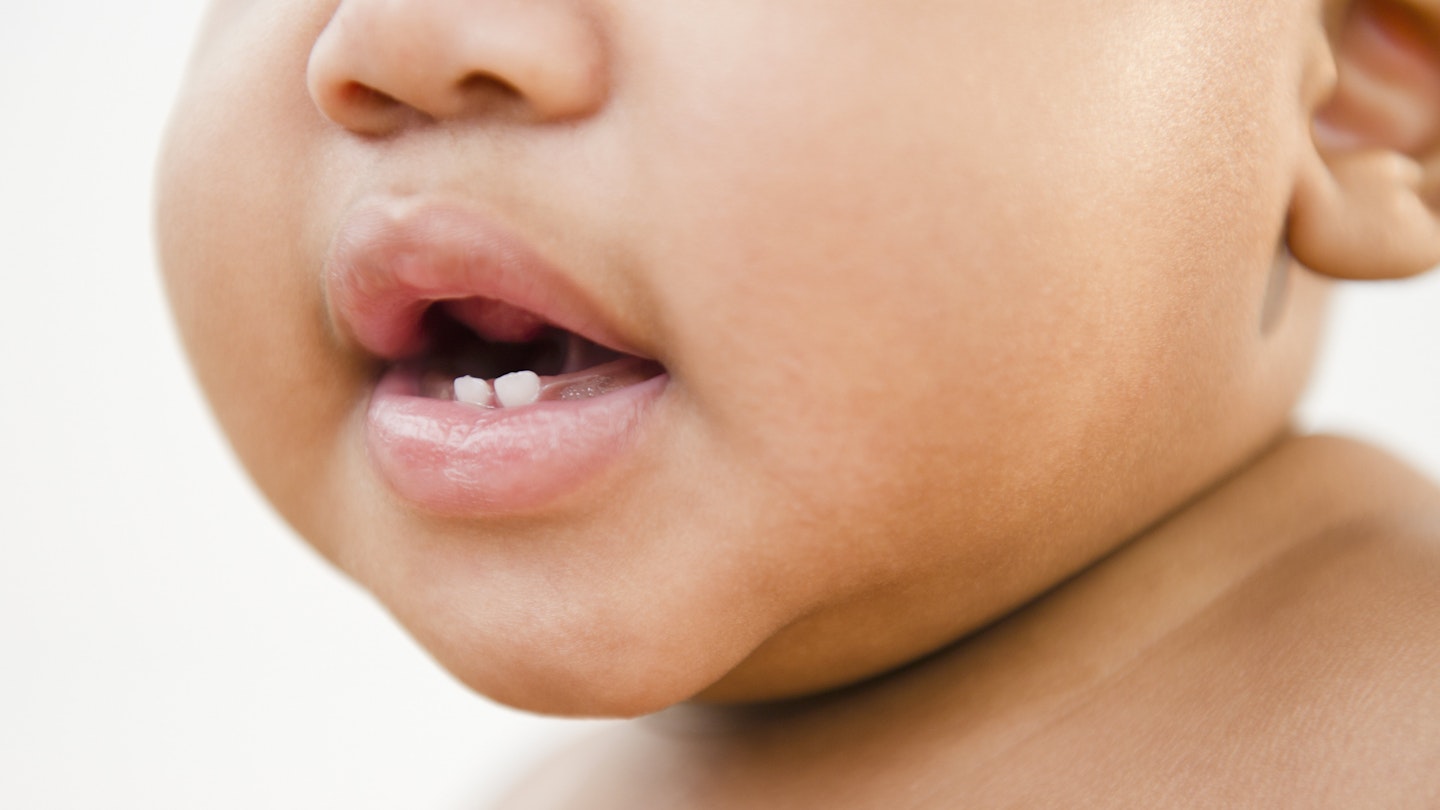So, you have inevitably been wondering (and Googling), 'When do babies start teething'. And for most parents, that's because you have noticed a change in your usually picture-perfect baby. If you’ve ever had a toothache, you know how all-consuming that pain can be. Now, imagine multiple teeth pushing through your gums at the same time. Ouch. Even as fully grown adults, we’d be cranky, off our food, and maybe even a little dribbly. So, if your usually happy little human has suddenly turned into a fussy, drool-covered mess, you might be asking yourself, 'Is my baby teething?'
Teething is a huge baby milestone, but we know it can also be one of the most challenging stages to navigate. So, we've put together a handy baby teething chart to give you a better idea of your baby's teething timeline and plenty of information, tips, and expert advice to help you ease little ones' discomfort and care for their new shiny teeth as they emerge.
When do babies start teething?
A bit of background first... Six weeks after conception, the cells that will eventually become your baby’s teeth start to form underneath their jaw. As a baby grows in your womb, these gradually become more solid and structured, and when they are born, your little one has a full set of teeth buds. These continue to grow until they’re right underneath the gum line when your baby is around three months old – and this is when teething symptoms typically start!
How long does teething last?
Although you might start to notice the symptoms, their first tooth may not begin to emerge until they are around six months old. Then teething usually lasts until they are about 25-33 months. It takes around eight days for a tooth to push through the gum and a few months to continue growing to full size at a rate of 1mm a month.
Signs and symptoms of teething
Your baby may bite to relieve the pressure they can feel in their gums, so receiving a nip on your fingers or while you’re breastfeeding can indicate a tooth is well on its way. When a tooth is ready to come through the gum, you’ll be able to see its white tip just underneath your baby’s gum line – exciting stuff, eh? Your baby's body is now releasing a chemical that causes the gum to become less dense so the tooth can push through more easily. But the tooth still must break through the top layer of her gum, and this can cause some discomfort for the baby and perhaps some sleepless nights for you!
Here are some early teething symptoms from the NHS to watch out for so you can be ready to ease a tooth’s arrival:
• Irritability
• 1 flushed cheek
• Red and sore-looking gum where the tooth is coming through
• A mild temperature of 38C
• Ear rubbing
• Biting
• Excess saliva production (using a bib will help prevent teething rash)
• Dribbles
• Rubbing cheeks
• Not sleeping well
• Refusing to eat
Do babies experience a loss of appetite during teething?
With some teeth, your baby might not feel up to feeding. This is because the suction can make their sore gums feel worse, and if they're weaning, they might also refuse solid food. Don't worry; hunger normally wins out, but if your baby is reluctant to feed for a few days, call your doctor or child's dentist to check everything is as it should be.
What order do baby teeth come in?
You’ll find that your baby will react differently to the different teeth types that come through – and what soothes an incisor might not work so well on a molar. The front teeth have flatter, thinner edges and tend to slide through the gums, so they are usually the easiest to cut. This is why it’s great to have a variety of different ways to help your baby during this time and also know when to expect the different types of teeth.
This baby teeth chart shows when your baby’s teeth will emerge:

1.) Lower central incisors - although you may notice the first signs of teething around the three or four months mark, the first teeth, these two front bottom teeth, can emerge as late as six months.
2.) Upper central incisors - the upper middle teeth come next. You can usually expect them a month after the bottom two.
3.) Upper and lower lateral incisors - at nine to 12 months your baby can expect four more teeth, one on either side of these central teeth, and these are her lateral incisors.
4.) First molars - these will appear at around 14 months at the top and bottom of your baby’s mouth, leaving a gap between them and her incisors.
5.) Canine teeth**—**at 18 months, these four sharper teeth will emerge in the gaps between the incisors and first molars.
6.) Second molars - these will emerge at the back of her mouth at around 26 months.
Remember, the age babies teeth come through varies a lot, but you can expect your little one to have a full set of baby teeth by the time they turn three. If they reach their first birthday without any teeth emerging, then it’s a good idea to visit your dentist.
How to soothe a teething baby
Some babies might have all these symptoms, while others may sail through without a sign. And some teeth might cause a run of restless nights, while others will pop up one morning without warning.
Thankfully, there are lots of teething remedies that will help your baby when they need it, from teething rings to gels. The secret is to experiment and mix and match your methods with each new tooth to find what really works.
Here are some ideas:
Teething toys
Experiment with teething toys to find one that offers just the right pressure to ease discomfort. Have a selection of different shapes, too – circular teethers are best when they're cutting their front teeth, but they’ll need a longer, thinner design to reach their molars. The nobbly bits on teethers can provide extra relief, and will give your baby’s gums something to grasp onto. Buy one with a range of textures so they can experiment. A teething necklace can also be a great option for on-the-go.

Pain relief
You can give your baby paracetamol from two months and ibuprofen from three months, but whichever brand you choose, make sure it is suitable for babies. Paracetamol relieves mild to moderate discomfort before a tooth comes through. When your baby is actually cutting a tooth, ibuprofen is more effective as it helps reduce inflammation. Always give the recommended dosage and check with your doctor if you’re not sure.
Another pain relief option are teething granules, which contain a natural pain reliever to ease discomfort and easily dissolve in your baby’s mouth. Teething gels can also help ease discomfort as they contain a small dose of antiseptic which will help numb baby's gums, but make sure you use one that is suitable for babies.
Teething pain tips
Here are some handy tips that may help soothe your little one's gums:
-
Numb your baby’s gums. Give them a teether that’s been chilled in the fridge for half an hour. Or if they’re over six months, offer some cold water in a cup.
-
Give your baby a clean flannel soaked in warm water to suck on. The warmth can ease aching gums and help teeth break through the gums.
-
Give your little one cold snacks. Depending on your baby's age, feed chilled fruit purées or a homemade ice lolly or pop a chunk of frozen banana or plums in a baby feeder mesh bag for them to gnaw on safely.
-
The crook of your little finger makes a great teether. But do wash your hands first. And, if the baby is restless at night, gently press on the gum with your little finger – it’s a great way to soothe the baby without waking them up.
-
Give your baby lots of extra cuddles and kisses as teething can be a really unsettling time and they'll need lots of love and reassurance, don't worry the baby smiles will be back soon!
How to look after babies' teeth during teething
You can start brushing your baby's teeth as soon as they appear. Use a baby toothbrush with a tiny smear of fluoride toothpaste.
Don't worry if you don't manage to brush much at first. It is important to get your baby used to brushing their teeth as part of their daily routine. You can help by setting a good example and letting them see you brushing your own teeth.
We asked registered Dentist Dr Laura Geige for her expert advice on how to care for your baby's teeth during teething, and here's what she said:
Caring for your baby's teeth during teething is crucial for establishing good oral hygiene habits that will last a lifetime. Here are some tips and instructions that mothers will find invaluable:
-
Early Brushing: Begin brushing your baby's teeth when the first tooth appears. Use a soft-bristled baby toothbrush with a tiny smear of fluoride toothpaste (about the size of a grain of rice). This not only helps keep the teeth clean but also familiarizes your baby with the brushing routine.
-
Gentle Cleaning Techniques: Brush teeth using gentle circular motions. Avoid vigorous scrubbing, which can irritate the gums. If your baby resists, try making it a fun activity by singing songs or letting them hold the toothbrush.
-
Pre-Tooth Gum Care: Before the teeth emerge, clean your baby’s gums with a clean, damp cloth after feedings. This helps to remove bacteria and creates a healthy environment for the new teeth.
-
Avoiding Sugary Substances: Refrain from giving your baby sugary drinks or foods. Sugary substances can lead to early tooth decay. Stick to breast milk, formula, or water for hydration.
-
Teething Toys and Rings: Provide teething toys or rings to soothe your baby’s gums. Chilling these toys can offer extra relief. Avoid freezing them, as extreme cold can harm your baby’s gums.
-
Regular Dental Visits: Schedule your baby’s first dental visit by their first birthday. Early dental check-ups can help detect potential problems early and provide guidance on proper oral care routines.
Baby teething FAQs
When should babies have their milk teeth?
By the time they're around two and a half, your little one is likely to have their full set of 20 baby teeth.
What is a teething skin rash?
When your baby is teething they may develop a teething rash on the cheeks, chin, neck and chest. It'll look like chapped skin or small red bumps. Keep in mind that teething should not cause a rash on your baby's arms, legs or back – if you notice signs of a rash in any of these areas contact your paediatrician.
Can teething cause a temperature?
There’s no evidence to support that teething causes fever, but occasionally babies experience a mildly raised temperature. If your baby does develop a fever with a body temperature of over 38 degrees, they may not be very well and be experiencing an illness or infection, so make sure you get them seen by your GP.
Can teething cause diarrhoea?
Dr Laura Geige says, "Teething itself does not directly cause diarrhoea. However, the process of teething involves increased drooling, which can lead to looser stools in some babies. The swallowed saliva may irritate the gastrointestinal tract, leading to a change in stool consistency. It’s important to distinguish between normal teething-related changes and true diarrhoea, which involves frequent, watery stools. If your baby experiences persistent diarrhoea, it could be due to an underlying infection or another health issue, and you should consult a paediatrician."
Can teething cause vomiting?
Dr, Laura Geige says, "Vomiting is not typically associated with teething. While teething can cause significant discomfort and irritability in babies, it does not directly cause vomiting. If your baby is vomiting, it’s likely due to another illness or gastrointestinal issue. Persistent vomiting requires medical attention to ensure that your baby is not suffering from an infection or other serious condition. Always monitor for other symptoms such as fever, lethargy, or dehydration, and consult your healthcare provider if these symptoms are present."
Can teething cause nappy rash?
Dr. Laura Geige says, "Teething can indirectly contribute to nappy rash. The increased drooling and saliva production during teething may lead to more frequent bowel movements or looser stools, which can irritate the sensitive skin in the diaper area. To prevent nappy rash, change diapers frequently, keep the diaper area clean and dry, and use a barrier cream to protect the skin. Allowing some diaper-free time can also help to air out the skin and prevent rash. If the rash persists or seems severe, consult your paediatrician for advice."
Do babies sleep more when teething?
Some parents claim that their babies sleep more during teething, perhaps believing that they need more rest due to their growing teeth or them feeling out of sorts, however, most parents will say the opposite is true, with teething pains keeping babies up at night instead.
About the expert
Dr. Laura Geige is a GDC registered dentist, aesthetician with level 7 qualification in medical aesthetics, an assessor, clinical trainer, cosmetic dermatology and facials specialist. Driven by a profound understanding of skincare, she has significantly contributed to the development of product portfolios for beauty brands through her adept diagnosis and treatment of various skin conditions.
Proud aunt to her teen niece, Zara Mohammed is a Digital Writer for Mother&Baby. She has 10 years freelance writing experience creating lifestyle content for various platforms, including pregnancy, women’s health, parenting, child development and child mental health, plus lots of fun seasonal family articles and celebrity news.
